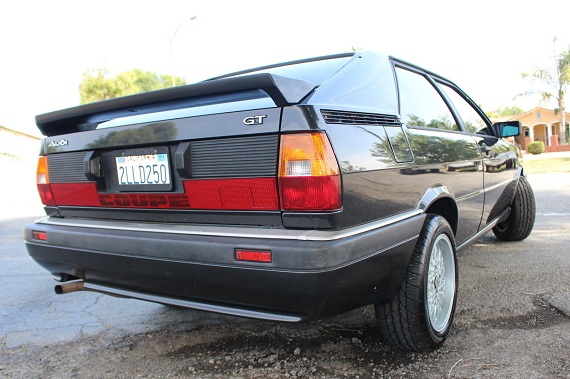For a brief period, the Porsche 912 enjoyed quite a bit of success. Released in 1965 and serving as Porsche’s entry-level model the 912 was essentially a 911 with a more basic drivetrain. With its inherently better balance relative to its more advanced sibling, the 912 sold very well upon initially being made available before Porsche decided it would be discontinued so as to make way for the mid-engined 914. Other than a brief reappearance in 1976, the 912 only enjoyed a 5 year model run from 1965 to 1969 and, like many entry-level vehicles nearly 50 years later, they remain relatively rare, especially with low mileage. The car featured here, a 1968 Porsche 912 Coupe, located in Florida, is enshrouded in questions, but with only 12,000 miles and on offer for no reserve it could end up as quite an interesting buy.
Month: June 2014
As I head up to Sonoma for a weekend of NASCAR, I get to indulge in another incongruous-but-fun journey, loading M5 up with camping gear and parking it next to trucks, campers, and RVs. It even gets a few nods and smiles among this very different type of car enthusiast, but staying in a tent surrounded by generators leaves a little to be desired. This is a long way of saying yet again that I very much want a campervan to increase the efficiency and comfort of my roadtrips. Today we have an earlier but very nice Vanagon, in the exact color as my brother’s non-Westy van. It’s only adventured 84k miles in its 3+ decades and has had some recent maintenance that indicates it could go as many years and a lot more miles. It has a few needs but the cleanliness in undeniable and with no reserve, it could be a good deal relative to most clean Westies.
Click for details: 1982 Volkswagen Vanagon Westfalia on eBay
2 CommentsMercedes-Benz has never been one to adopt fads quickly, unless you count recent years. Which makes the Heckflosse, or fintail models of the late 1950s and early 1960s rather interesting, as fins on American cars were dying out. Yet Mercedes seemed determined to include them in their new offerings at the time. By the end of the 1960s, this styling feature was all but gone. This 1967 Mercedes-Benz 200D represents the end of the run for the fintail. For sale in North Carolina, this car has a lot of originality in tact and has First we’ll take a look at a late model 1967 200D that has had an engine rebuilt but has plenty of patina in tact.
CLICK FOR DETAILS: 1967 Mercedes-Benz 200 on eBay
2 CommentsWith the revival of the roadster in the early 1990’s Porsche decided it was finally time to introduce a new model, something the marque had not done since the ’70s. Rather than design another GT to replace the outgoing 928 and 968, Porsche went with a mid-engined entry-level roadster that would appeal to a wider demographic than the more hard-edged 911. With a 2.5 liter flat-6 and 5-speed manual directing their energies to the rear wheels the Boxster was generally very well received and sold like mad. While admittedly the early Boxster was a bit soft and a bit slow, flaws Porsche would correct a few years later with the Boxster S, it still served its basic purpose of broadening the Porsche audience. The car featured here comes from the first generation: an Arctic Silver 1998 Porsche Boxster, located in Florida, with 56,950 miles.
CLICK FOR DETAILS: 1998 Porsche Boxster on eBay
Comments closedDo you think you know Audi and Volkswagen products from the 1980s well? There are a lot of people who claim to, but it seems that at times even VAG didn’t know what it was producing. Take, for example, this 1986 Audi Coupe GT. Now, according to most sources for a long time, if you wanted to get the digital dashboard in a 1986 Audi Coupe GT, you had to get the “Commemorative Edition” GT which came only in white or graphite. Yet as the owner of what was originally a Oceanic Blue non-CE Audi GT with an original digital dashboard, I can attest that in fact cars outside of the normal production run were fitted with the somewhat quirky bit of 1980s fad technology. If you talk to most Audi folks, they stand firmly in two camps. The small camp says that the digital dash is really, really cool; the far larger camp sees it as a glitchy gimmick that seldom works properly and is hard to service. But having owned one for the best part of two decades now, I can say mine has never experienced much of an issue. It had neat features, such as the “shut off the entire dash” feature which left you only with a speed reading. I think I used it once, only to show someone that it existed. At startup, you could tell your friends that you had programmed the cover art to Ghost in the Machine by The Police into your dash. Much more fun, though, was the ability on the fly to switch the dash from English to Metric units; if you were alone on the highway with an unsuspecting passenger, you could flip the dash into metric and then brag about how you were going “150” with ease. Okay, maybe I was the only one who thought it was funny, but there really weren’t many advantages to the digital dash otherwise. Despite that a smattering of 1986 and 1987 (non-“Special Build”) cars, seemingly with no particular order or logic, were fitted with the Atari-esque bit of technology:




